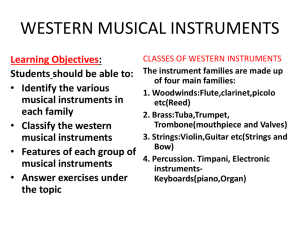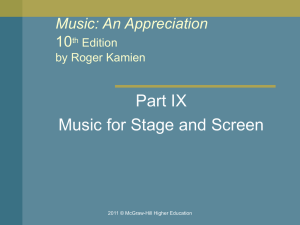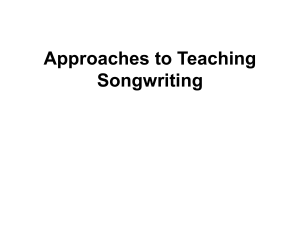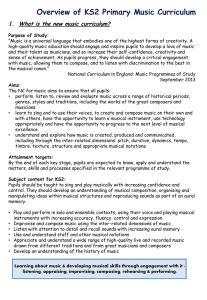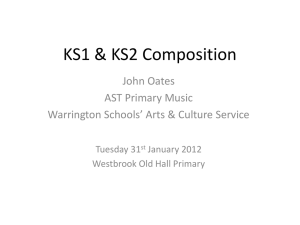Music for Young Children
advertisement
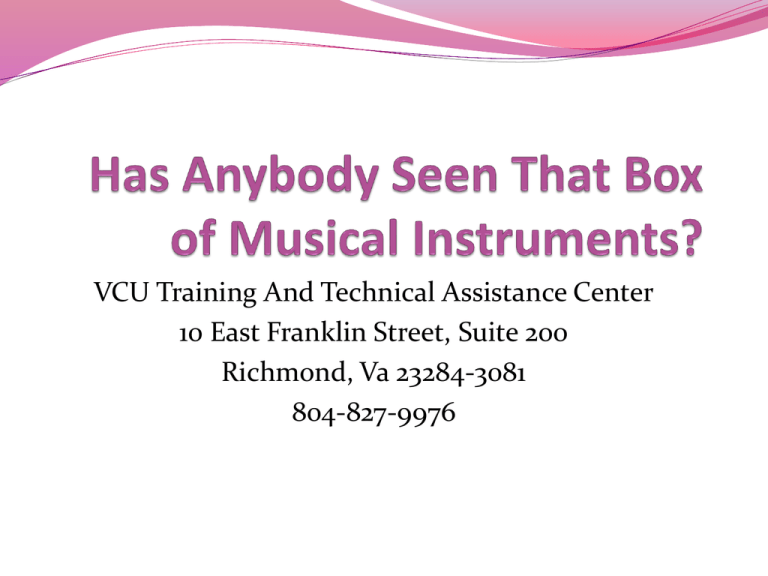
VCU Training And Technical Assistance Center 10 East Franklin Street, Suite 200 Richmond, Va 23284-3081 804-827-9976 Musical Concepts and Expression “Music is combing voice, instrumental or mechanical sounds to create melody, rhythm, or harmony” -(Dodge, Colker, & Her0man, 2002) Learning Objectives Discover strategies for introducing musical instruments in a group setting Develop ideas to use music in the classroom in developmentally appropriate ways Explore different types of music to use with musical instruments Explore ideas for making musical instruments and Have fun! Getting Started… Young children are not music critics! You look and sound a lot more stupid when you worry about how you look and sound! Music & Brain Research All early sounds, including music & rhythms, play profound effect in shaping the brain. When music resonates with our body rhythms, it is a powerful influence on our alertness and our ability to learn. Most classical music is in tune with our body rhythms. Research suggests that listening to music during the first 3 years of life helps the brain form patterns that are essential to the learning process. The brain adapts easily during the early years, so a wide variety of music should be introduced. Music in Early Childhood Classrooms The goal of music in ECE classrooms is to help children develop a positive disposition for music. Beliefs Behind a Child-Centered Music Curriculum All children have musical potential. Children bring unique interests & abilities to the music learning environment. Very young children can develop critical thinking skills through music activities. Children come to music experiences from diverse backgrounds. Children should experience exemplary musical sounds, activities, and materials. Beliefs behind a Child-Centered Music Curriculum (cont.) Children should not be encumbered with the need to meet performance goals. Children learn best in pleasant environments. Diverse learning environments are needed to serve the developmental needs of individual children. Children need effective adult models. Stages in the Development of Music I can listen to the music. I can respond to music with my body. I can create music. I can understand music. I can write music. I can play music. Critical Issues in Using Music Developmentally Appropriate Pleasurable Varied Individual and Social Integrated Benefits of Using Musical Instruments with Young Children Using musical instruments builds and develops listening skills Allows children to experience rhythms Children can classify and discriminate between sounds Allows children to explore and be creative Motor Development Children develop motor skills when they strike the keys on a xylophone, dance to lively music, or play a kazoo. These activities involve the practice of large and small muscle control. Social Skills and Cultural Awareness Music encourages participation, sharing, and cooperation. Music is part of early bonding. Music is part of the culture of childhood. Aesthetic Development How does the music make us feel? What do we hear in the music? How can we express the music? Why do we respond the way we do to music? Cognitive & Language Development Comparison Directional Words Self expression Developing preferences & making choices Increased vocabulary Recognizing patterns Musical activities that relate to story reading can focus children’s attention Children learn awareness of the components of music: melody, pitch, rhythm, tempo, dynamics and timbre. Getting Started with Musical Instruments Music experiences must be matched to children’s developmental needs Start with the teacher using one musical instrument as an auditory prop Introduce one instrument at a time at circle time; talk about safety and taking care of the instruments. Add the prop(s) to a designated shelf in your classroom Let children explore and experiment! Continuing with Musical Instruments Everyone wants a turn! How many musical instruments do you have in your classroom? What types of musical instruments do you have ? Start by designating a “music center” in your classroom Move it outside! Playground Parade Whole Group Music Activities Have children “vote” on their favorite musical instrument (graph as a math activity). Using homemade instruments Begin with familiar songs and music If you have limited instrument have ½ of your group use an instrument and the other ½ a scarf, then trade. Gaining Participation If a child does not want to participate, they may begin with rolling something back and forth (truck) to the music Children may participate by observing A child with developmental delay will still have the opportunity for gaining language and social skills even if they do not want to use an instrument’ Children may be more interested if they get to make and use their own instrument Adapted Instruments Using model magic, include a large grasp mold around the stick Attach bells to an elastic band and place on the child’s wrist or ankle Instruments can have a ribbon run though them and then tied to the child’s clothing Using switches Using craft sticks for extensions Using Musical Instruments Throughout The Daily Schedule Greeting & Departing Routines Transition Planned Large Group Planned Small Group Outside During Centers Instrumental music at Naptime Music Center Activities Children can explore musical sounds and ideas individually Children explore their own interests and abilities through specially prepared materials and activities Children can discriminate between high and low notes. While at the music center, the children can use high and low signs with a partner when the xylophone is played by their peer. Provides opportnities for children with special needs Rhythm Sticks Children will use “Tap Your Sticks” rhythm sticks to the song beat of a song. Rhythm Sticks CD Sing a song and get children to clap to the beat; then transfer to using chunky rhythm sticks. Drums Have the children march around the circle and follow the beat of the drum made by the teacher.(Begin with a slow and very steady beat.) Variation: Let a child take a turn! Let children use their homemade drums (made from oatmeal containers. ) Have children will march in a circle creating different steps (high, long, fast, slow). Encourage modifications of homemade drums by using different size containers and contents Bells The children will ring their bell when they hear the word bell in the story. Jingle seriation; place one to five bells in felt bags in order according to the loudness or richness of the jingle. Place jingle ribbons throughout the classroom. Throw a beanbag to ring the bell. Composing Music with Young Children Using board maker symbols Writing songs for instruments played Song boards (Place a song on large poster board; children can decide what musical instrument will be played for each word. These can be changed using board maker symbols so that you sing each day in a different way!) Music to Use with Musical Instruments Vivaldi (Bolero), Ella Jenkins, Hap Palmer Grieg (In the Hall of the Jazz CD Mountain King Beethoven (all), Herbert (March of the Toys) Saint-Saens (Carnival of the the Animals) ; Zydeco Harp Piano Horns African Drumming Recorded Music with Musical Instruments Tiptoe to the “Dance of the Sugarplum Fairies & allow children to take turns playing the triangle. Paper plate streamers. Tap dancing with quarters on our shoes. Moving with scarves. Listening for specific musical instruments when music is played from “Peter and the Wolf”. Children will stand up when they hear their instrument. Books and Musical Instruments Zin, Zin the Violin Peter and the Meet the Orchestra Wolf Carnivale of the Animals The Philharmonic Gets Dressed Max Has Two Sticks Things We can do to Encourage Appropriate Music Activities in the Classroom Create a supportive physical & emotional environment Provide opportunities to explore music without pressuring students to perform Respect what is comfortable for the child Music needs to be fun Social interaction is a key part of music experiences Vary the musical experiences and include history and information. During music and movement activities, notice if a child… Enjoys listening to music Enjoys playing an instrument and is able to follow the beat Experiments with different instruments Makes up new words to songs Is able to create movements to go with your rhythm and directions Interacts with others in music and movement activities Recognizes the following instruments by sight and sound: guitar, flute, piano, drum, trumpet www.childrensmusic.org/light4.html Don’t be afraid to teach a new way, Use more music everyday Sing a fact or maybe two, Suddenly it is fun to do! Just be careful with your song Facts through music last quite long. and SING!…tune: ABC song

